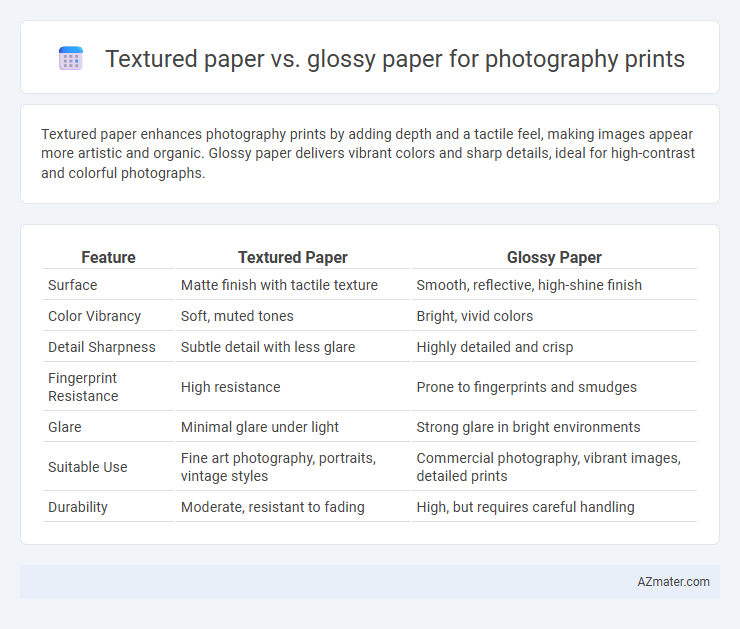Textured paper enhances photography prints by adding depth and a tactile feel, making images appear more artistic and organic. Glossy paper delivers vibrant colors and sharp details, ideal for high-contrast and colorful photographs.
Table of Comparison
| Feature | Textured Paper | Glossy Paper |
|---|---|---|
| Surface | Matte finish with tactile texture | Smooth, reflective, high-shine finish |
| Color Vibrancy | Soft, muted tones | Bright, vivid colors |
| Detail Sharpness | Subtle detail with less glare | Highly detailed and crisp |
| Fingerprint Resistance | High resistance | Prone to fingerprints and smudges |
| Glare | Minimal glare under light | Strong glare in bright environments |
| Suitable Use | Fine art photography, portraits, vintage styles | Commercial photography, vibrant images, detailed prints |
| Durability | Moderate, resistant to fading | High, but requires careful handling |
Introduction to Photography Print Paper Types
Textured paper offers a tactile surface that enhances fine art and black-and-white photography by adding depth and dimension to prints, while glossy paper provides vibrant color saturation and sharp details ideal for high-contrast images. Photography print paper types vary significantly in finish, weight, and material composition, with common categories including matte, luster, satin, and glossy, each influencing the final print's appearance and durability. Selecting the appropriate paper depends on the desired visual effect, print longevity, and the specific photographic style being showcased.
What is Textured Paper?
Textured paper for photography prints features a surface with tactile patterns, such as canvas, linen, or watercolor finishes, enhancing the visual depth and artistic feel of images. These papers absorb ink differently than glossy options, reducing glare and adding a subtle dimension that complements fine art and black-and-white photography. Photographers often choose textured paper to achieve a more traditional, handcrafted appearance that emphasizes detail and richness without the reflective shine of glossy paper.
What is Glossy Paper?
Glossy paper features a shiny, reflective coating that enhances color vibrancy and sharpness, making photographic prints appear more vivid and detailed. This type of paper is ideal for images requiring high contrast and brightness, such as portraits and landscapes with intricate details. Glossy paper tends to resist fingerprints better but can be prone to glare under direct lighting conditions.
Texture vs Gloss: Key Differences
Textured paper offers a tactile surface with visible fibers or patterns that enhance depth and shadow detail, ideal for fine art photography emphasizing a classic or vintage feel. Glossy paper provides a smooth, reflective finish that intensifies color vibrancy and sharpness, making it suitable for vibrant, high-contrast images. Choosing between textured and glossy paper depends on desired visual impact and how texture or shine influences photo presentation.
Visual Impact: Color and Sharpness
Textured paper offers a unique tactile surface that enhances depth and dimension in photography prints, providing a subtle diffusion of light that softens color saturation and sharpness for a more artistic and vintage look. Glossy paper delivers vivid color reproduction and high sharpness due to its smooth, reflective surface, making images appear more vibrant and detailed with higher contrast. Choosing between textured and glossy paper depends on desired visual impact: textured paper emphasizes texture and muted tones, while glossy paper maximizes color intensity and crispness.
Handling Light: Reflection and Glare
Textured paper absorbs light, reducing reflection and glare, making it ideal for viewing photographs under various lighting conditions. Glossy paper reflects more light, producing vibrant colors but causing noticeable glare and reflections that can obscure details. Selecting textured paper enhances visibility by minimizing light interference, while glossy paper prioritizes color saturation at the expense of glare control.
Durability and Longevity Comparison
Textured paper offers enhanced durability due to its thicker fibers and resistance to fingerprints, making it ideal for long-term photography prints exposed to handling. Glossy paper, while providing vibrant color saturation and sharp image details, tends to be more susceptible to scratches and fading over time without proper protective coatings. For longevity, textured paper generally outperforms glossy options by maintaining image integrity and resisting environmental wear longer in archival conditions.
Best Uses for Textured Paper in Photography
Textured paper enhances photography prints by adding a tactile dimension that brings out fine details and depth, making it ideal for black-and-white portraits, landscapes, and vintage-style images. Its matte finish reduces glare and fingerprints, providing a classic, artistic feel suited for gallery displays and fine art photography. Textured paper also excels in archival quality, offering durability and resistance to fading over time, which is crucial for preserving high-value prints.
Ideal Scenarios for Glossy Paper Prints
Glossy paper is ideal for photography prints that require vibrant colors and sharp details, making it perfect for portraits, landscapes, and commercial advertising images. Its reflective surface enhances contrast and depth, giving photos a high-impact, professional appearance suitable for gallery displays and promotional materials. Glossy finishes work best in environments with controlled lighting to minimize glare and showcase the image's vividness effectively.
Choosing the Right Paper for Your Photographic Style
Textured paper enhances photographic prints with a tactile, artistic feel, ideal for fine art and black-and-white images, emphasizing depth and detail. Glossy paper offers vibrant colors and sharp contrast, perfect for vivid landscapes and portraits requiring high visual impact. Selecting the right paper depends on your photographic style and the desired presentation effect, balancing texture with color intensity.

Infographic: Textured paper vs Glossy paper for Photography print
 azmater.com
azmater.com